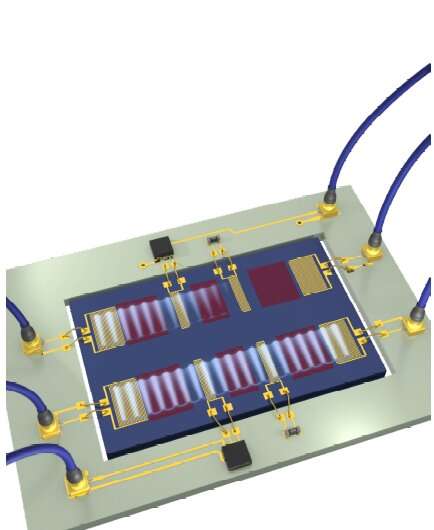June 5, 2020 feature
A system for the nonreciprocal transmission of microwave acoustic waves

Acoustic waves have been found to be highly versatile and promising carriers of information between chip-based electronic devices. This characteristic is ideal for the development of a number of electronic components, including microwave filters and transducers.
In the past, some researchers have tried to build devices in which waves are transmitted between two ports in a non-symmetric way. These are known as nonreciprocal devices. These devices could be particularly promising for the manipulation and routing of phonons, quasiparticles associated with acoustic waves. Building nonreciprocal devices that transmit acoustic waves, however, can be highly challenging, as acoustic systems typically transmit waves in a linear way.
Researchers at Harvard University have recently achieved the non-reciprocal transmission of non-reciprocal acoustic waves using a nonlinear parity-time symmetric system. This system, presented in a paper published in Nature Electronics, is based on two coupled acoustic resonators placed on a lithium niobate surface.
"My colleagues and I noticed the emerging field of microwave acoustics, which involves practical devices for next-generation telecommunications and new quantum systems," Linbo Shao, one of the researchers who carried out the study, told TechXplore. "When we dug into this field, we realized the nonreciprocal control of the acoustic waves, which enables isolators and circulators, is desired but hard to achieve yet. This challenge is what we are trying to address in this work."
To achieve the nonreciprocal transmission of microwave acoustic waves, the researchers used a parity-time (PT) symmetric system that was previously found to work well in optical applications. This type of symmetric system has been the focus of a substantial amount of studies, thus the physics behind it is well understood.
In their work, Shao and his colleagues decided to apply this PT system to a lithium niobite acoustic wave platform they developed. This unique design strategy is the key innovation behind their recently study.
"We employed strong piezoelectric coupling of lithium niobate to bring about an adequate acoustic gain, which is essential to a PT system," Shao said. "Our surface acoustic wave (SAW) nonreciprocal devices work at a much higher frequency than previous acoustic nonreciprocal systems."
In their evaluations, the researchers found that the nonlinear devices they developed could attain 10dB of non-reciprocal acoustic wave transmission at a frequency of 200MHz. While the researchers primarily demonstrated their system's potential at 200MHz, their findings suggest that this frequency could be extended to 10Gz, simply by geometrically scaling up the devices.
Theirs is a remarkable result, as previously developed devices for the nonreciprocal transmission of microwave acoustic waves typically only work below 2MHz. The system created by Shao and his colleagues is also significantly more compact than most existing systems, which facilitates its integration within other devices.
"Overall, our study confirms that utilizing piezoelectricity, we can easily introduce the gain and loss for acoustic waves, or build a non-Hermitian system," Shao said. "Acoustic/mechanical systems by themselves are usually linear and passive, but when they are coupled to electronics, as we did in our work, they become nonlinear and active (non-Hermitian)."
In addition to linking acoustic systems with rich non-Hermitian physics, the new platform presented by Shao and his colleagues could ultimately enable the development of acoustic devices that were previously deemed impossible to fabricate. The new nonlinear system they developed could be integrated within a variety of electronic components, including acoustic isolators and circulators.
"We are now building our integrated acoustic/phonon platform on lithium niobite and believe that it will be a nice platform, where researchers can either have fun with non-Hermitian physics or build various devices/elements they want for acoustic signal processing," Shao said.
More information: Linbo Shao et al. Non-reciprocal transmission of microwave acoustic waves in nonlinear parity–time symmetric resonators, Nature Electronics (2020). DOI: 10.1038/s41928-020-0414-z
© 2020 Science X Network





















